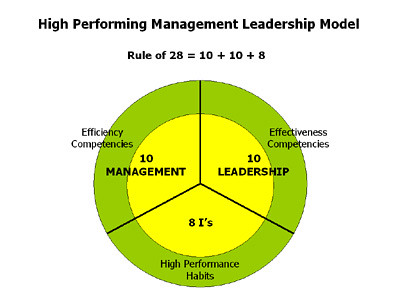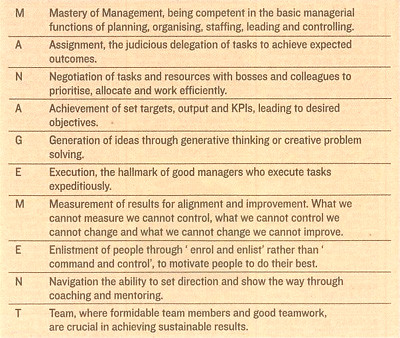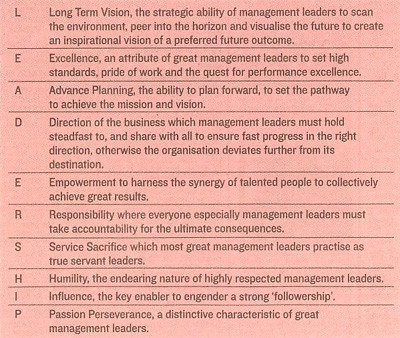ACKNOWLEDGEMENT
This article was published in The Star on January 8, 2009.
Reproduced here with permission from the author
Dr. Wilson Tay, CEO of MIM
and from
The Malaysian Institute of Management (MIM)
*************************************************************************
MANAGEMENT and leadership are two sides of the same coin. Management is about making things happen and achieving expected results through people.
In managing, we consider the quality, characteristics and behavioural aspects of management leadership to achieve superior performance.
Over the last decade there has been too much emphasis on “hero” or “iconic” leaders, while “servant” or “management” leaders who go about achieving great results quietly are often forgotten.
These humble and quiet achievers are referred to as the Level 5 leaders in Jim Collin’s book Good to Great. They go about building profitable, sustainable businesses and accomplish great results in an unassuming way.
These management leaders achieve great outcomes because they have learned the “secret code of managership” comprising 28 personal competency requisites and performing habits of management leadership. Through this mastery, they are able to enlist their superiors, fellow managers and workers to work zealously together to pursue a common mission and shared vision.
Management Leadership
Many management writers have incorrectly distinguished managers as those being able to perform tasks that only deal with the efficiency of the business, and leaders as those who can undertake tasks which focus on the effectiveness of the business. However, great management leaders possess the capabilities of both an efficient manager and effective leader, depending on the situation.
Hence, management leadership is the exercise of both these capabilities and competencies through individual high performance within an understanding of operational and strategic requirements. One characteristic of great management leaders is that they are also good followers.
If necessary, they can be just one of the team players, allowing others to assume the leadership role.
Characteristics of Management Leaders
High performing leaders become successful because of the reverence and support from their team of competent managers. Outstanding management leaders always acknowledge that they stand on the shoulders of the great managers that they have. No great management leader can achieve a sustainable superior outcome on his own.
There is now a renewed clarion call for managers to pursue and promote “management leadership” or “managership” through continuous professional development and life-long learning. The challenge is to master the ability to learn faster than the rate of change happening around us.
What is the Secret Code of Management Leadership?
I have created the mnemonics MANAGEMENT and LEADERSHIP to represent the 28 personal requisites of mastering management leadership – 10 efficiency and 10 effectiveness competencies plus eight performing habits. (See the following chart).

The first 10 management leadership or “managership” competencies are embedded in M-A-N-A-G-E-M-E-N-T, wherein lies the Secret Code of “Management” which essentially focuses on the EFFICIENCY of tasks to be achieved: (Table 1)
Table 1: MANAGEMENT

The next 10 managership competencies are endued in L-E-A-D-E-R-S-H-I-P wherein lies the Secret Code of “Leadership” which essentially focuses on the EFFECTIVENESS of tasks to be achieved: (Table 2)
Table 2: LEADERSHIP

Catalyst for Management Leadership
In order to catalyse the achievement of the aforementioned 20 efficiency and effectiveness competencies, we need to practise the 8 “I’s” Performance Habits:
- Inspire – to articulate the Vision and set Direction;
- Impart – to engage in Communication and provide Coaching;
- Influence – to inculcate Sincerity and build Trust;
- Inquire – to encourage Inquisitiveness and teach Problem Solving;
- Initiate – to motivate Action and instill a sense of Urgency;
- Improve – to enable Change and grant Empowerment;
- Implement – to measure Performance and focus on Results; and
- Innovate – to stimulate Creativity and seek out Opportunity
These 28 requisite competencies of Management Leadership (Managership) need to be learned, developed and practised by individuals in order to become high performing management leaders. Once these competencies are mastered, the challenge is to institutionalise and integrate a management leadership culture within the organisation.
Written by Dr. Wilson Tay, MMIM, MIM-CPT. Dr. Wilson Tay is the chief executive officer of the Malaysian Institute of Management. He is also an educator and consultant. His speaking engagements have included both public and private educational institutions. His expertise includes management leadership, knowledge management, creativity and innovation, entrepreneurship, human capital and talent management development, coaching and mentoring, and SMEs development.
For more information, please contact the Malaysian Institute of Management http://www.mim.org.my/ at Tel: +603 – 2164 5255 or email: enquiries@mim.org.my
No comments:
Post a Comment